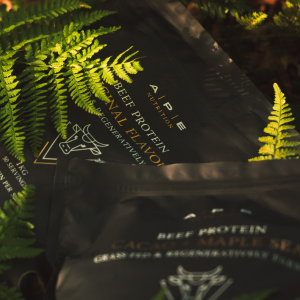Oyster, one of the most beneficial food sources of bioavailable minerals. The most notable being copper-balanced zinc. The human body requires a zinc-to-copper ratio of 8:1, therefore we need 8x the amount of zinc as we do copper, an increase in one causes a fall in the other. Oysters have the perfect ratio of these minerals.
I have worked with desiccated oyster capsules and fresh oysters as a food source of zinc for over a decade, witnessing their transformative effects on people's health. At least 30% to 50% of the individuals I work with show symptoms of zinc deficiency. The trouble with fresh oysters is that I've heard countless reports of food poisoning from a dodgy oyster, however, I've never encountered this with dried encapsulated oysters, making them my top choice (plus I've snapped a few knives fighting with the oyster shell, that I just prefer an easy life!)
Zinc is one of the hardest minerals to obtain from food sources, especially from a plant-based diet. I have seen long-term vegans announce they are vegan apart from oysters, and this has sustained them. Apparently, oysters are not sentient beings, as their nervous system has no brain, therefore they are incapable of forming thoughts or experiencing pain.
Zinc is one of the most essential nutrients the body needs, especially for the 3 P’s: Puberty, Pregnancy & Perimenopause. But zinc also plays a pivotal role in men's health, enhancing testosterone levels and sperm quality. Basically, we all need it, badly!
How do low zinc levels manifest in humans? Just before birth, women experience a surge in copper levels, aiding in contractions, as copper is conductive. It's important that zinc levels are raised after birth through diet, as copper lowers zinc. However, zinc deficiency could easily happen during pregnancy too as our needs increase, showing in stretch marks in the mother and low birth weight babies.
Adequate zinc levels are crucial for postnatal recovery, as low zinc levels after birth have been linked to postnatal depression and various health issues affecting the child.
Let's delve into how low zinc levels can show up:
Brain Health
ADHD, autism & anorexia are all linked to low zinc levels. Insufficient zinc levels can alter perception, this can present as ADHD & autism from an early age. Additionally, during puberty, the need for zinc increases and this can show up as anorexia - where the brain perceives the body as overweight. I’ve seen this connection with anorexia during puberty many times with clients, when the need for zinc is at an all time high. Nowadays it also seems everyone is being diagnosed with ADHD… there is definitely something going on here, we are missing the mark on fully nourishing ourselves (and pulling ourselves away from our phones, another culprit!)
Delayed Puberty and Stunted Growth
Zinc has growth factor. If your child is particularly small or has delayed puberty, look to zinc. In this six-month study, oral zinc supplementation significantly improved certain growth factors and reduced the risk of stunting. As an adult if you find yourself unable to grow a beard as a man, or notice unwanted facial hair growth as a woman, both scenarios indicate a zinc deficiency requiring attention.
Infertility and Hormonal Problems
Low sperm count in men, infertility, polycystic ovary syndrome (PCOS), miscarriage and insulin resistance are all linked with low zinc. Aside from zinc directly influencing hormonal health in both men and women, this study on rats also shows a link between low zinc and increased absorption of BPA, the hormone-disrupting chemical.
Rapid Aging
Does your skin scar easily after a cut or graze? Zinc plays a crucial role in wound healing, affecting both internal tissues and skin. Keloid scarring indicates low zinc levels. Replenishing zinc levels can improve hair growth, skin texture, and even help reduce the appearance of stretch marks or prevent them altogether, as zinc aids in the production of collagen and elastin. I personally made sure my zinc levels were sufficient before, during and after my pregnancy, and I didn’t suffer any stretch marks at that time. It’s only in the past year I’ve let my zinc levels get low (white spots on my nails being the indicator) and I’ve started to get stretch marks and elastin loss on my belly, say what!! Needless to say the oyster caps are on the go again!
Junk Food Cravings and Fussy Eating in Children
Do you crave junk food and experience loss of smell? Or have a fussy eating child? Zinc governs both taste and smell. If you find yourself needing excessive seasonings to taste your food or craving junk food with artificial flavours, it's likely you are low in zinc. Replenishing zinc levels can transform your palate, allowing you to enjoy simple, clean foods more. I have witnessed children being less fussy eaters when their zinc levels increase, my 7 year old boy included (to some degree!).
This also aligns with the taste and smell loss experienced with COVID-19. Zinc is rapidly depleted when the body fights off viruses or infections, so another reason to keep yourself topped up.
Low Stomach Acid
It's a catch-22: you need zinc, along with other minerals like potassium and iron, to produce hydrochloric acid in the stomach. Yet, low levels of stomach acid hinder nutrient absorption from food! The key is to consume bioavailable minerals consistently.
Low Immune System
If you suffer from recurrent infections and low immunity, zinc deficiency is associated with increased susceptibility to infections and higher risk of autoimmune diseases. Zinc influences signalling pathways of immune cells. If you or your child are ‘always ill’, take action with oysters!
I would recommend avoiding most zinc supplements as these can cause nausea and knock-out copper levels. Getting nutrients from food sources is always best. Opening up the capsules and adding them to a fruit rich smoothie is a sneaky and effective way to get more zinc into your child!
To recap here’s some signs that you are low in zinc and need some oysters in your life!
White spots on the nails
Hair loss and slow growth
Delayed puberty
Stunted growth
Rosacea
Keloid scarring
Stretch marks
Rapid aging
Depression
Infertility
Impotence
No/low taste or smell
Fussy eating (in children)
Low immunity
Low stomach acid
Lastly zinc opposes lead in the mineral wheel, which means if you have high lead levels, zinc can help lower them. Similarly, selenium opposes mercury, and silica opposes aluminium. Minerals are what you need to lower your heavy metal burden.
Selenium and iodine are essential minerals for fertility and reproductive health in both men and women. Additionally, they play a crucial role in regulating thyroid function, and they are naturally found together in oysters. Iodine in particular has been found to raise IQ in school children, yet another brain-boosting nutrient present in the humble oyster!
Here’s the Daily Value (DV) of nutrients from oysters
- Zinc: 555%
- Vitamin B12: 538%
- Copper: 493%
- Selenium: 56%
- Iodine 48%
- Iron: 40%
- Manganese: 20%
- Phosphorus: 12%
- Vitamin E: 9%
- Riboflavin: 9%
- Calcium: 7%
Another significant nutrient found in oysters is vitamin B12. This vitamin is crucial for the nervous system, and low levels have been linked to conditions such as psychosis and schizophrenia. Therefore, alongside the zinc and other important minerals found in oysters, they provide valuable support for mental health.
That’s a whole lot of motivation to get taking oyster on the regular, especially with zinc pretty much effecting EVERYTHING to keep us healthy humans. We would have a happier nation with everyone sufficiently nourished!






